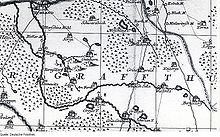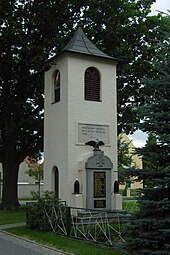Sella (Grünewald)
|
Sella
Community Grünewald
Coordinates: 51 ° 23 ′ 21 ″ N , 13 ° 59 ′ 12 ″ E
|
|
|---|---|
| Height : | 130 m above sea level NN |
| Incorporation : | 1938 |
| Postal code : | 01945 |
| Area code : | 035756 |
Sella (around 1757 and still around 1825 called Wendisch Sella , Sorbian Zelnje ) is now part of the municipality of Grünewald in the Oberspreewald-Lausitz district in the Ruhland district in southern Brandenburg .
geography
Sella is located southeast of the city of Ruhland in Upper Lusatia on the border with the Free State of Saxony .
To the west and north of Sella are other places of the office Ruhland, Lipsa , Guteborn and immediately to the north, adjacent Grünewald. Further north are Hohenbocka and the city of Senftenberg with its districts Peickwitz and Niemtsch . In the east, south and partly in the west Sella borders on places of the Free State of Saxony - Wiednitz with its district Heide , Grüngräbchen , Cosel and Zeisholz .
history
Name development
Sella was first mentioned as Sell in 1455 . The name is probably derived from the Sorbian stem zel- ("green"), which is also indicated by the neighboring Grünewald. Another possibility is a derivation of Old Sorbian * želv for turtle . In the years 1525 and 1588 the place was already called Sella . In 1558 and 1678 there were slight modifications to Selle or Sölla . From 1800 the place was called Wendisch Sella , in contrast to the place of the same name near Königsbrück . The Sella near Königsbrück has been desolate since 1938 . The name of the place was changed to Lindhain by the National Socialists from 1936 to 1945 , and the neighboring Lipsa was renamed Lindenort in this context .
Local history
The Sella, mentioned in 1455, is a Slavic round building with an annexed street perimeter village . Sella and the neighboring Cosel belonged to the manor of the Augustinian monastery in Altendresden . The bailiff of Upper Lusatia, Karl von Münsterberg, withdrew both goods from the monastery under the pretext of refused Turkish tax and sold them to his brother-in-law Wenzel von Schönburg († 1523) on Hoyerswerda for his underage sons Wanke and Georg on Sunday after Jacobi in 1523 for 4500 marks . After a complaint by the Augustinians to Ludwig II because of the injustice that had happened to them, the new guardian, Karl von Schönburg zu Pirstein and Trautenau , had to buy both villages from the monastery again for 3,000 florins. After they reached the age of majority, Wanke and Georg, who as bastards were not entitled to use the name “von Schönburg”, named themselves after their Kosel estate as “von der Kosel” and acquired other villages in the area. After the death of one of the two brothers, his sons Alexander and his brothers were enfeoffed with Cosel, Sella, Zeisholz , Oßling and Lieske in 1558 . In 1584 Alexander von der Kosel sold the village of Sella for 4,000 florins to a Herr von Rosenhain on Grünewald.
In 1554 Sella was parish off to Schwepnitz . From 1621 it belonged to the Cosel manor and from 1665 to the Grünewald manor. In the course of the results of the Thirty Years War , Sella came to the Electorate of Saxony as part of Upper Lusatia . As a result of the Congress of Vienna in 1815, the Saxon-Prussian border was drawn around Sella; Sella fell to Prussia and, with the exception of the north, was surrounded on three sides by Saxon territory.
From 1825 to 1952 Sella belonged to the district of Hoyerswerda . In 1938 Sella, which was then called Lindhain, was incorporated into the neighboring Grünewald. With the district reform in 1952, Sella and the entire area around Ruhland came to the Senftenberg district .
Population development
| Population development in Sella selected years from 1777 to 1999 | |||||||||||||
|---|---|---|---|---|---|---|---|---|---|---|---|---|---|
| year | Residents | year | Residents | year | Residents | year | Residents | year | Residents | year | Residents | year | Residents |
| 1777 |
10 possessed men 10 cottagers |
1825 | 110 | 1871 | 160 | 1885 | 168 | 1905 | 175 | 1925 | 159 | 1999 | 125 |
Attractions
In 2003 the village square was redesigned. In the village square there is a bell tower that was built in 1886. The tower bell was bought by the city of Schwepnitz. The bell strikes every full and half hour and 6:00 p.m. for two minutes. There is a war memorial on the bell tower for those who fell in the First World War .
The former culture house was used as a disco and was inactive for a long time. It is currently being converted into a car repair shop.
Web links
- Homepage of the Ruhland office, section History of the Grünewalde municipality , accessed on June 5, 2009
- Article in the Lausitzer Rundschau on March 18, 2009 , accessed on June 5, 2009.
- Sella in the Digital Historical Directory of Saxony
Individual evidence
- ↑ Ernst Eichler : Slavic place names between Saale and Neisse. Volume III, VEB Domowina-Verlag, Bautzen 1993, p. 230
- ↑ Hermann Knothe : History of the Upper Lusatian Nobility and its Goods: vom XIII. until the end of the XVI. Century . Vol. 1. Leipzig 1879, pp. 311-312.
- ↑ Brandenburg Statistics (PDF)

